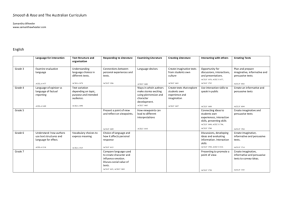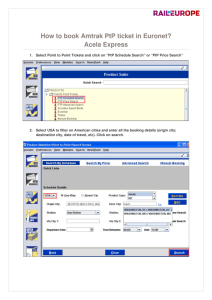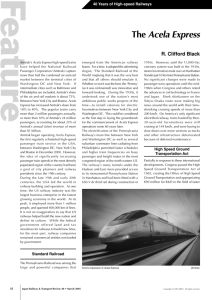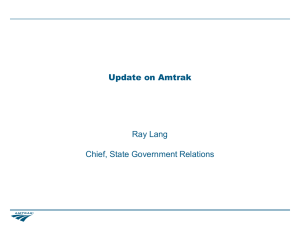Reliability-Centered Maintenance Program on the ACELA Express
advertisement
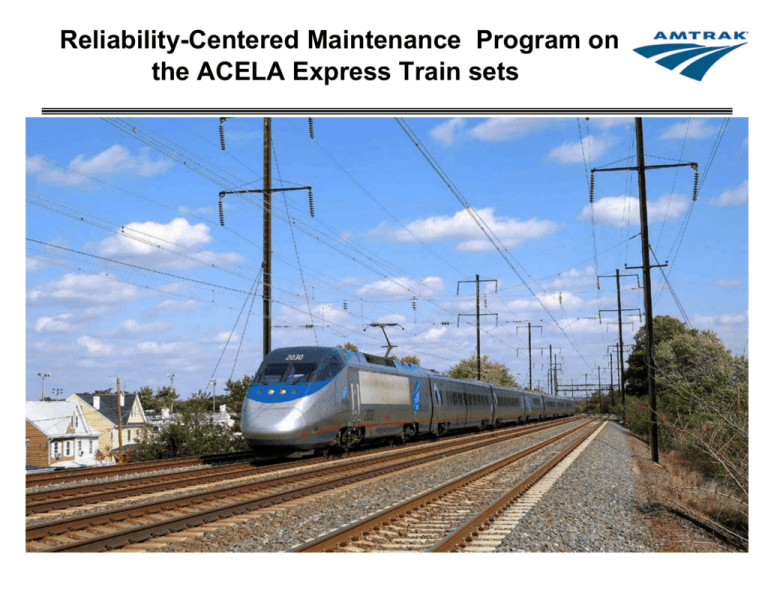
Reliability-Centered Maintenance Program on the ACELA Express Train sets Amtrak ACELA Express Amtrak currently runs ACELA Express Service from Washington, DC to New York City and Boston. There are currently 34 train assignments in this current time table representing the Northeast Corridor covering every hour from 5 am to 7 pm. The ACELA Fleet has 20 Train sets configured with two Power Cars and six Coach Cars each. Acela Power Cars Continuous 4,600 kW/ 6,000 HP 4 asynchronous AC traction motors 3 GTO-Type inverters, 2 for propulsion and 1 for auxiliary power required by the power car and passenger cars. Top operating speed of 150mph (165mph designed) The Main Transformer has two primary windings connected in parallel for operating overhead AC supply of 12kV at 25Hz or 12.5kV at 60Hz and series connection when the overhead input is 25kV at 60 Hz. Braking system incorporates blended regenerative/rheostatic dynamic Braking High Speed Trainset Tilting System Each Passenger Car is equipped with an active computer controlled and electro hydraulically activated tilting system. Maintains low lateral acceleration through curves at high speed. The curve detection is sensed by the lead power car triggering the tilt function. Amtrak currently operates at 7 inch cant deficiency (it is designed and tested at 9 inch cant deficiency). ACELA Passenger Demand for Service 20 18 16 14 12 Required Fleet 10 8 6 4 2 0 2005 2006 2007 2008 Future? ACELA Passenger Demand for Service Amtrak developed Continuous Maintenance program (CM) for Planned Maintenance (PM) to increase availability of equipment. PM requirements divided into manageable segments performed during Service and Inspection dwell time. Previous to CM two Trainsets were shopped for PM Amtrak and RCM: Background Amtrak established Condition-Based Maintenance (CBM) as corporate policy in July 2006 Amtrak reviewed and validated all Acela Train set maintenance requirements using Reliability-Centered Maintenance (RCM), per 49 CFR Part 238 Appendix E. Acela Level I (Daily), Level II (92Day) and Level III (Long Term) requirements were reviewed and completed in 2006. Reliability-Centered Maintenance Reliability-Centered Maintenance (RCM) as used by Amtrak incorporates several techniques and tasks: Maintenance Effectiveness Review Root Cause Analysis Condition Based Monitoring Maintenance Effectiveness Review (MER) Maintenance Effectiveness Review MER analysis identify the applicability and effectiveness of maintenance tasks. • Applicability criteria is the specific set of conditions for a given task type that must be met to improve or maintain system or equipment inherent reliability • Effectiveness criterion judges whether a specific task would be capable of reducing the failure for its failure consequence. Task periodicities are based on evidence of need and assessment of risks. Maintenance Effectiveness Review Cross Functional Stakeholders Mechanics who perform the tasks Operational Management Representative Equipment Engineering Representative Operator or End User OEM Representative Facilitator Maintenance Effectiveness Review Task Type On Condition, renew life based on comparison with standard, initiating action upon reaching potential failure point. Age Limit, renew life regardless of condition, taking action prior to “anticipated” failure point. Failure Finding, determine whether a hidden failure has occurred, initiating corrective action when initial failure occurs. Maintenance Effectiveness Review Failure Consequences Safety, functional failure results in possible loss of occupants or equipment Operational, functional failure results in indirect economic loss plus direct cost of repair Non-operational, functional failure results in direct cost of repair MER Component Analysis Spreadsheet 1. Component Information • Part Number • Description • Car (PC/TC) • Quantity 3. Risk Assessment 2. Functional Description 5. In-Service Monitoring Plan • Current ITM and Monitoring • Additional Diagnostic Capabilities • Additional Test Procedures • Probability of Failure (failure history: OEM and Rev. Service) • Severity of Failure (FMECA failure effects) 4. Condition Baseline • OEM Recommended Life Cycle • Bench Test Results • Teardown Inspection Results Root Cause Analysis Root Cause Analysis Amtrak has incorporated a standard maintenance practice on how a Root Cause Analysis session is performed. The method used is based on Reliability Center Incorporated’s PROACT system. Preserving Event Data Ordering the Analysis Team Analyzing the Data Establishing Root Causes Communicating the Findings Tracking for Results TILT SYSTEM RCA RESULTS • Constant displacement pump and unloading circuit installation – Increased pump reliability and reduction in service delays – Improved onboard oil filtration, decreasing hydraulic oil contamination and reduction in component wear – Reduction in necessary periodic external filtration to maintain standard ISO level • Minimum and centering pressure switch upgrade – Reduction of in service failures • Tilting load locking valve replacement with dual pressure transducer – Allows for condition based monitoring and implementation of continuous maintenance tasks – Reduction of in service failures • Quick connect fitting upgrade – Reduced external hydraulic leakage – Reduction of in service failures Acela Tilting Delay Minutes M inutes of Delay ACELA Tilting Delay Minutes By Month Based on Amtrak's ARROW Reports 188 200 180 160 140 120 100 80 60 40 20 0 O 171 159 152 124 104 82 68 79 80 53 48 44 54 21 c 6 t0 No v 06 c e D 06 Ja n 07 Fe b 07 M 0 ar 7 Ap 7 0 r M ay 07 Ju Months n 07 l Ju y 07 g u A 07 p e S 07 O c 7 t0 No v 07 c e D 07 Acela Tilting System MDBF ACELA Tilting System MDBF Maximum Likelihood Estimation (MLE) Series1 Linear (Series1) M ean D istan ce B etw een F ailu re 50,000 46,289 45,000 40,000 32,891 35,000 27,551 30,000 23,494 25,000 18,535 20,000 15,509 12,726 15,000 16,199 13,751 11,848 10,428 12,251 10,000 8,300 11,391 5,000 0 No 6 0 v De 6 c0 J an 07 F eb 07 M a 7 r0 Ap 7 r0 M a 7 y0 Ju ne 07 Months Ju l 7 y0 A ug 07 S ep 07 Oc 7 t0 No 7 0 v D 0 c e 7 Condition Based Monitoring Condition-Based Monitoring Dynamic Monitoring detects potential failures that emit abnormal energy such as vibration or acoustical waves. Particle and Chemical Monitoring detects potential failures by analyzing discrete particles or traceable quantities of chemicals released in the component’s operational environment. Physical Monitoring detects potential failures by analyzing changes in the physical structure such as cracks, wear or dimension. Temperature Monitoring detects potential failures by sensing temperature differentials in the component’s operational environment. Electrical Monitoring detects potential failures that produce changes in resistance, conductivity, dielectric strength and potential. Remote Condition Monitoring Actual, En-route Notification of Reportable DC Ground Fault Element of June 2007 Acela Fleet Health Analysis Proposed Dynamic health display to be located in Maintenance Facilities Seventy-Two (72) Annulments Have Been Avoided Since October 2006 Cumulative Acela Annulments since January 2006 250 Acela annulments trend was 8 per month 200 150 Savings = 72 Amtrak takes over Acela Maintenance 100 50 New “RCM” Acela ITM Actual annulments now average 3 per month 0 6 7 6 6 7 7 8 6 7 7 6 6 6 7 7 7 6 7 6 7 7 6 7 06 06 -0 -0 -0 -0 -0 -0 -0 -0 -0 -0 -0 -0 -0 -0 -0 p-0 -0 -0 -0 -0 l-0 g-0 l-0 rr rr t v t v c c y y n n n n n b b p g u u a a p p c c o o a a u e e u e e J J Ja A Ju Ja A Ju Ja Fe M O N Fe M O N A S D A S D M M Actual FY06 Projected Fewer Terminations 70 Cumulative Acela Terminations since January 2006 60 50 Acela terminations FY06 trend line Savings = 9 40 30 Amtrak takes over Acela Maintenance Actual terminations trending lower 20 10 New “RCM” Acela ITM J an -0 6 Fe b- 0 6 Ma r- 0 6 Ap r- 0 6 Ma y -0 6 J un -0 6 J ul -06 Au g- 0 6 Se p- 0 6 Oc t- 0 6 No v-0 6 De c-0 6 J an -0 7 Fe b- 0 7 Ma r- 0 7 Ap r- 0 7 Ma y -0 7 J un -0 7 J ul -07 Au g- 0 7 Se p- 0 7 Oc t- 0 7 No v-0 7 De c-0 7 0 Cumulative FY06 Projected Reliability-Centered Maintenance Program on the ACELA Express Train sets
